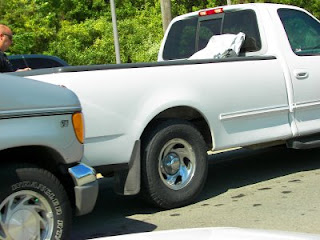 Sylvania's finest blocking off two lanes of traffic near the scene of an accident
Sylvania's finest blocking off two lanes of traffic near the scene of an accidentWhile driving through downtown Sylvania this afternoon I found myself stuck in a rather lengthy traffic backup on eastbound Monroe Street just before the US-23 bridge. I could see the flashing lights about a quarter mile ahead, and I resigned myself to a 15-minute toasting in the hot July sun.
However, I was quite irritated to find that the source of the traffic jam was a 3-car (or maybe a 4-car) minor fender bender. In fact, I could see no visible signs of damage to any of the vehicles save for a few shards of plastic trim on the ground in front of one of the vehicles.
No injuries. No significant damage. Eight people milling about exchanging information, and four cops writing tickets and directing traffic.
Meanwhile, hundreds of other people traveling on Monroe Street each lost 15 minutes or so of their lives in this misguided vehicular farce. If we assume 300 people making $15 an hour were inconvenienced by this preventable delay, this accident represented $1125 in lost productivity. Add to this $100 or so in wasted fuel by all the idling cars, and this starts getting expensive.
All because a handful of well-meaning-but-clueless people are under the mistaken notion that a minor traffic accident somehow equates to a crime scene in need of pristine preservation.
 Left: Dinged but driveable
Left: Dinged but driveableThe rule of thumb in a traffic accident is pretty simple: if the accident is relatively minor and there are no significant injuries, the motorists involved should move their cars off the road and out of the way of oncoming traffic. Yet many folks act as though a CSI squad is going to descend on the scene, collecting samples, conducting forensic tests, and taking measurements.
Heck, if anything the act of standing around a bunch of driveable vehicles in the road is likely to increase the chances of another (and perhaps more serious) accident occurring as motorists weave through the chaos. The Ohio Insurance Institue publishes an auto accident checklist with other tips to keep in mind in the event of an accident, and you can print the PDF document off and keep it in the glovebox.
I really cannot fault the police for the delays, as they arrived some time after the drivers of the vehicles decided to have a picnic in the middle of the road. Yet it seems that in this collection of rattled folks absorbed in their twists of accidental fate not a single person had the presence of mind to say: "Hey: everyone seems to be OK, so let's move the cars out of the way."
A little common sense is quite useful, but it is often in short supply these days.




